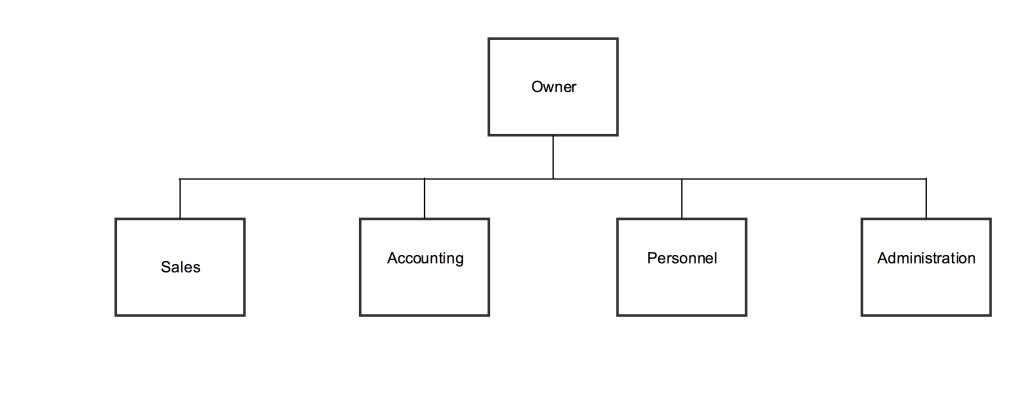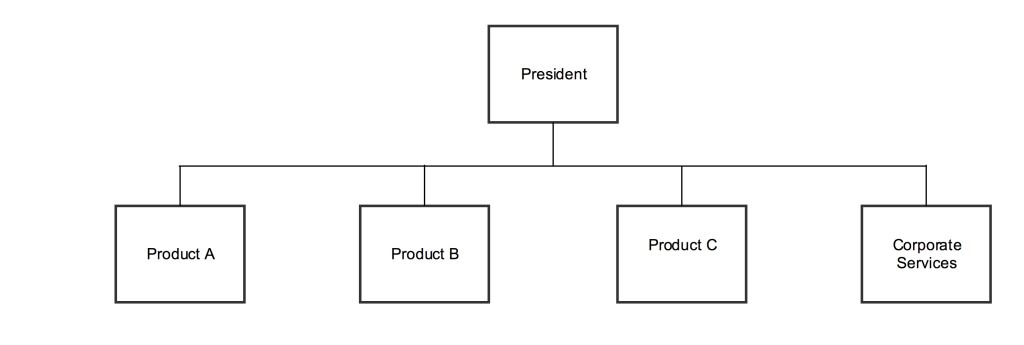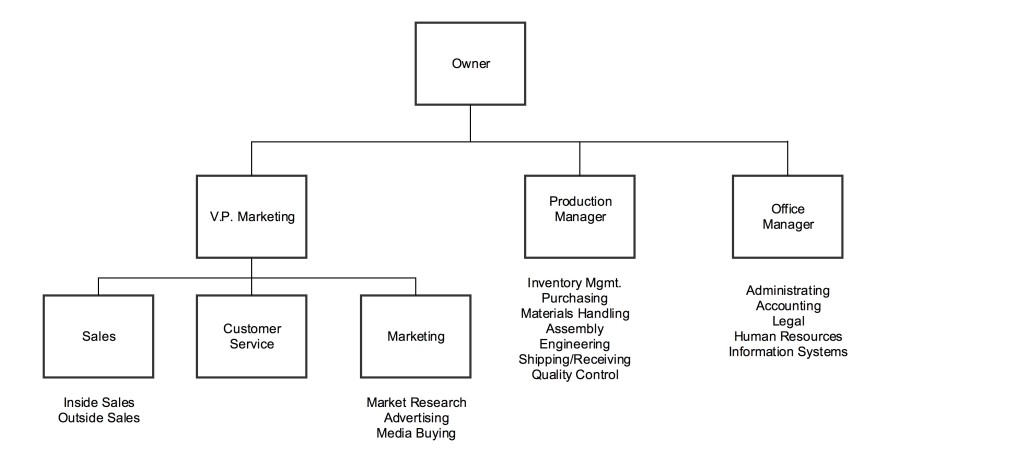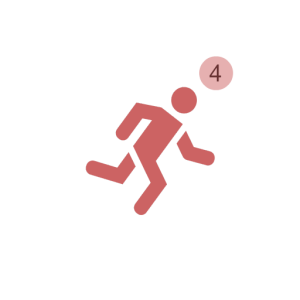Developing Your Organizational Plan
Your business structure for success
Developing Your Organizational Plan
Now that you have conducted an analysis of your business, set your objectives and goals, and examined the resources you will need to achieve your objectives, it’s time to turn your attention to the organizational structure that best suits your business needs.
Organizational structure refers to the way positions are organized to perform the functions needed to achieve your strategic plan. Jobs must be structured. The right people must be hired for the right positions at the right time. Many business owners try to organize functions around the people they have rather than finding the right people to handle the functions that must be done to accomplish their mission.
An organization chart is a visual representation of the positions needed in your business and the relationships between those positions. It’s more than just a formality. Your organization chart serves as an important tool for accomplishing your strategic planning. It’s a system that ensures your business has the right people doing the right jobs at the right time.
You will learn more about analyzing your personnel needs and developing your personnel systems in the Systems for Success course on personnel management.
Selecting the Best Organizational Structure for Your Business
Your organization chart is a fundamental management tool. Many small business owners tend to hire people they know or people who impress them rather than hiring people with the specific set of talents and skills necessary to meet specific objectives. With an organization chart, you look at your organization in terms of the functions that must be performed to operate at an optimum level, not how to make your current staff fill every need.
With an organization chart in place, you can see where and how well your current employees fit into the ideal organizational structure. If they don’t fit, you may need to start making adjustments to your staff.
This system is more important than it might seem on the surface. It can help you avoid costly hiring mistakes such as hiring a sales manager when a sales representative might do, or hiring a bookkeeper when you really need a controller.
It also helps prevent future personnel problems. For instance, if the company needs a bookkeeper now but anticipates that a controller will be needed in six months, the bookkeeper can be brought in with the knowledge that the controller position is going to be filled by a different level of person in six months. This way there is no resentment or uncertainty on the part of the bookkeeper when the senior staff person is brought in as their boss. This is one example of how planning with an organization chart can be beneficial.
Your organization chart also helps you paint a picture of the future of your business that can motivate employees to help you create that future. Employees can see what positions will be filled in the future and can take steps to receive training in areas that might interest them. The organization chart can be a powerful tool to convey your vision for the company and get all your employees working toward that vision.
As you think about how your organization should be structured, consider the following questions:
- How will you run your business?
- How will you make business decisions?
- How involved are employees in business decisions?
- What kind of environment do you want to create?
Your leadership and management style will have an impact on the type of structure you put in place, as will your mission and business objectives. Three traditional organization structures are functional, divisional, and matrix.
Functional Organization Structure
In the functional organization structure, employee roles are organized according to the functions that need to be performed to achieve the overall business mission. In a functional structure, individuals usually report to a manager, supervisor, or team leader who is responsible for coordinating operations for that area. Functional areas include things like sales, accounting, administration, and personnel.
Functional Organization Structure
Most small businesses will choose a functional organization structure, or at least start with one. The functional structure is often chosen for small businesses because it uses logical and time-proven methods. It also groups people in areas of specialization, making training easier and allowing more control.
The main disadvantage of a functional structure is that it can invite an “it’s not my job” attitude. It can narrow the focus of key employees, making it difficult for them to see the big picture. It can also reduce teamwork and coordination between employees of different departments.
Divisional Organization Structure
A divisional structure is built around divisions, or related products and customers. A division may be set up to focus on a particular customer group or to develop a specific product or service. Divisions can also be structured around different product lines or technologies. For example, a company that sells computers may have a division responsible for hardware, another responsible for software, and a third responsible for computer accessories. Or a manufacturer of cleaning products may have a division that focuses on the commercial market and another that focuses on the consumer market. An example of division by product line might be an exercise equipment manufacturer who has one division responsible for treadmills, another for exercise bikes, and a third for stair-step machines.
Divisional Organization Structure
The main advantage of a divisional organization structure is that it places focus on the product line or customer group. In a divisional structure each division is responsible for its own profits. This structure usually improves the coordination of functional activities.
A disadvantage of the divisional structure is that it generally requires more managerial talent. There is also often increased costs due to the duplication of basic services between divisions.
Matrix Organization Structure
The matrix organization structure is basically a compromise between functional and divisional organization. There are functional departments like production, finance, or marketing, and there are also product groups that are simultaneously members of a functional department and a project team. These product groups are often temporary and change depending on current business needs.
A matrix structure might benefit companies that frequently introduce new product lines or new technologies or that are very project oriented.
Matrix Organization Structure
The main advantage of a matrix organization structure is that it facilitates a rapid response to change. This structure is oriented toward end results and pinpoints product-profit responsibility.
Because employees are part of both a functional division and a project group there is the potential for conflict in authority and disunity of command. For this structure to be successful managers must be very effective in human relations.
Innovative Organization Structures
Today, many businesses are choosing to develop their own innovative organization structures. For example, many companies are using self-directed work teams or choosing not to assign job titles. These structures tend to be much more informal and change as the business needs change.
Small businesses generally don’t have the multiple layers of management that have plagued many larger businesses and resulted in major restructuring and organizational “flattening.” A small business owner with strong leadership skills can usually work within a traditional organizational framework and still achieve the advantages these more innovative structures attempt to achieve. Leadership skills are the key, however. The Systems for Success course on leadership and motivation will cover the leadership skills you need to assure your company thrives within whatever organizational structure you implement.
Creating Your Organizational Plan
Your organization chart will reflect both where you’re at now and where you want to be in the future. Before developing your organization chart, you need to create your organizational plan. Don’t worry at this point if you have one person fulfilling multiple roles. Concentrate on what needs to be done, not on who will do it — focus on positions, not people.
- Review your strategic operating plan and list every function necessary for the successful completion of your plan. Don’t assign names.
- List every function and activity your company is currently responsible for. Functions not listed will either not get done or will not receive the attention they should, so be sure to make the list complete.
- Group related functions together and assign them to individual positions — not people. Every function should be assigned to a position. Assign functions to the lowest skill level position possible. Try to avoid overlap and duplication of functions.
- Once functions are assigned to a position, define the responsibilities for the position and its authority.
- Group similar positions into departments. For instance, inside sales positions and outside sales positions would all be part of the sales department.
- Determine which positions will report to which. Observe the unity-of-command rule. This means each person has just one supervisor. Under no circumstances should an employee be made to report to more than one person. Even in a matrix organizational structure, each employee should report to only one supervisor to avoid conflicting instructions and priorities.
- Place positions on your organization chart with target dates of when each position will be filled.
At this point you are creating the picture of what your organization will look like in the future and what functions each position will have two to three years from now. As the business owner you shouldn’t be dealing with day-to-day operational functions unless the company is very small. If right now you are the one responsible for the sales or bookkeeping functions, ask yourself if you always want to do that function. If not, plan what position will do the function and make sure it goes on the organization chart.
Your organization chart will help you use your resources efficiently and effectively. It will also show growth paths — where your growth will occur, when, and why.
More information on analyzing your personnel needs can be found in the Systems for Success course on personnel management.
Sample Organization Chart for Small Company
Developing Your Organization Chart
When developing an organization chart, there are three other areas that need to be considered: lines of authority and relationships, span of control, and organization layers.
Lines of Authority and Relationships
Lines of authority simply refers to the authority one position exercises over another position. In the diagram above, the owner has the highest level of authority. The vice president of marketing reports to the owner. If the sales department has a sales manager, that position reports to the vice president of marketing. Any inside and outside sales staff then report to the sales manager.
This authority relationship is critically important. It’s only with a clear understanding of these “line relationships” that responsible decision making and effective communication can take place.
Determining lines of authority is often the starting place in developing an organization structure. Problems can occur if people are confused as to their responsibilities and decision-making authority. Consider your business and the employees you have. Who do they report to? Who has decision-making authority? Who doesn’t have authority but is a key advisor to another position?
Determine the line relationships that will exist among the various positions on your new organization chart.
Span of Control
Span of control deals with the number of people who report to a specific manager. Generally, the greater a manager’s span of control, the lower the cost to supervise individual employees. However, a manager is limited in the number of employees they can effectively manage. When determining how many employees will report to any one manager, you should consider both functional tasks and managerial tasks. If managers have their own functional tasks to complete, as is often the case in a small business, they may be limited in their ability to effectively manage others. Four to eight direct report employees is usually the maximum number any one manager can effectively manage. The only exception to this guideline is when the positions be managed are functionally similar and fairly routine. In that case, one manager might be able to effectively manage 10 to 12 direct report employees.
Organization Layers
Organization layers refers to the number of levels of management in an organization. Today, there is movement toward a “flattened organization,” which pushes the decision-making power down to the front lines and eliminates many of the middle management layers of organizations. This is usually not an issue with small businesses, but it’s something to be aware of as your business grows.
TAKE ACTION!
Determine Your Current Business Structure Needs.
Determine Your Future Business Structure Needs
Assess Your Current Positions
Create Your Organization Chart









Want to share results? Ask a question? Or maybe just collaborate with other members? Post a comment!